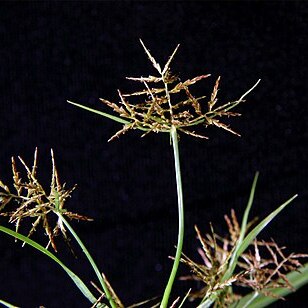Herbs, perennial, rhizomatous. Culms single or close together, trigonous, (10–)40–80(–120) cm × 1.2–2.5(–5) mm, glabrous. Leaves 2–5, pleated, (10–)20–50(–90) cm × 2–5(–10) mm. Inflorescences: spikes 1–4(–7), loose, broadly ovoid to ovoid-pyramidal, 25–35 × 25–35 mm; rays (4–)5–6(–8), (1–)3–8(–16) cm, glabrous; 2d order rays (0–)1–5, 5–15(–50) mm; bracts 4–7, ascending at 30–45°, pleated, (5–)20–40(–60) × (2–)3–8(–11) mm; 2d order bracts 1–4 per ray, 5–10(–30) × 0.5–1 mm, scabridulous; rachilla persistent, wingless (or very narrowly winged, not clasping achene). Spikelets (10–)20–35(–45), seemingly flattened proximally from spreading floral scales, becoming terete apically, linear, (10–)13–18(–25) × 1.2–1.5(–1.6) mm; floral scales deciduous, (10–)12–20(–25), laterally light reddish brown to dark red, medially greenish, laterally ribless, medially 3–5-ribbed, oblong-ovate, 1.7–2(–2.4) × 0.9–1.2 mm, apex obtuse, barely reaching next scale, apex entire, emarginate, mucro at most 0.3 mm. Flowers: anthers 0.4–0.5 mm; styles 0.3–0.6 mm; stigmas 1–1.8(–2) mm. Achenes dark brown, narrowly oblong, (1.3–)1.4–1.6(–1.7) × (0.3–)0.4–0.5 mm, base cuneate to ± stipelike, apex acute, not apiculate, surfaces papillose.
Perennials. Rhizomes short, surculose. Culms 35-110 cm tall, slightly stout, compressed triquetrous, smooth, base slightly swollen. Leaves shorter than or equaling culm; sheath brown, long; leaf blade 4-6 mm wide, flat or slightly folded, margin scabrid. Involucral bracts 4-6, leaflike, basal 2 or 3 longer than inflorescence, remaining ones shorter than inflorescence. Inflorescence a compound or decompound anthela; rays 6-10, to 15 cm, each with 3-5 raylets; raylets to 7 cm, ± thin. Spikes broadly ovoid, with 8-18 spikelets. Spikelets laxly distichous, linear, 0.8-4 cm × less than 1 mm, subterete, oblique to spreading, 6-32-flowered; rachilla thin, flexuose, wings white, hyaline, caducous. Glumes dark blood-red on both surfaces, lax, elliptic, ca. 2 mm, membranous, 3-5-veined, keel green, margin apically white hyaline, apex rounded. Stamens 3; anthers linear; connective prominent beyond anthers. Style short; stigmas 3. Nutlet blackish brown, oblong, ca. 2/3 as long as subtending glume, 3-sided, slightly prominently punctate. Fl. and fr. Jul-Aug.
Perennial herb, apparently long-rhizomatous, 0.5-1.4 m high. Leaf blades 4-8(-10) mm wide, flat. Culm scapose, 3-angled, 2-3 mm in diam. at middle. Inflorescence a very diffuse compound anthela, ± 100-200 mm in diam. Subtending bracts 3-6, overtopping inflorescence. Spikelets compressed, 10-20 x 0.5-0.8 mm, 10-20-flowered. Glumes distant, oblong, obtuse, ± 2.2 mm long. Flowering time Jan., Mar. Nutlet oblong, 1.8 x 0.6 mm, 3-angled, dark brown appearing grey, surface minutely reticulate.
A sedge. It keeps growing from year to year. It grows 30-100 cm high. It forms a loose tuft. The stalks have 3 angles and are thickened near the base. There are small corm-like underground stems or rhizomes. The blades are narrow and 4-6 mm wide. They are weakly folded The sheaths are light brown. The flowers are in groups at the one level and there are leafy bracts.
A tufted, perennial herb, up to 0.6 m high. Inflorescence a 30-200 mm wide anthela consisting of 1-3 sessile spikes and usually 2-10 stalked spikes or groups of spikes on 10-150 mm long peduncles. Spikelets less than 1 mm wide. Glumes reddish brown.


